Choosing a plan for a vegetable garden can be as time-consuming as caring for the garden. It’s fundamental since it determines the course of all subsequent gardening efforts. Below we learn vegetable plant spacing chart, seed spacing, plant-to-plant spacing, and row-to-row spacing.
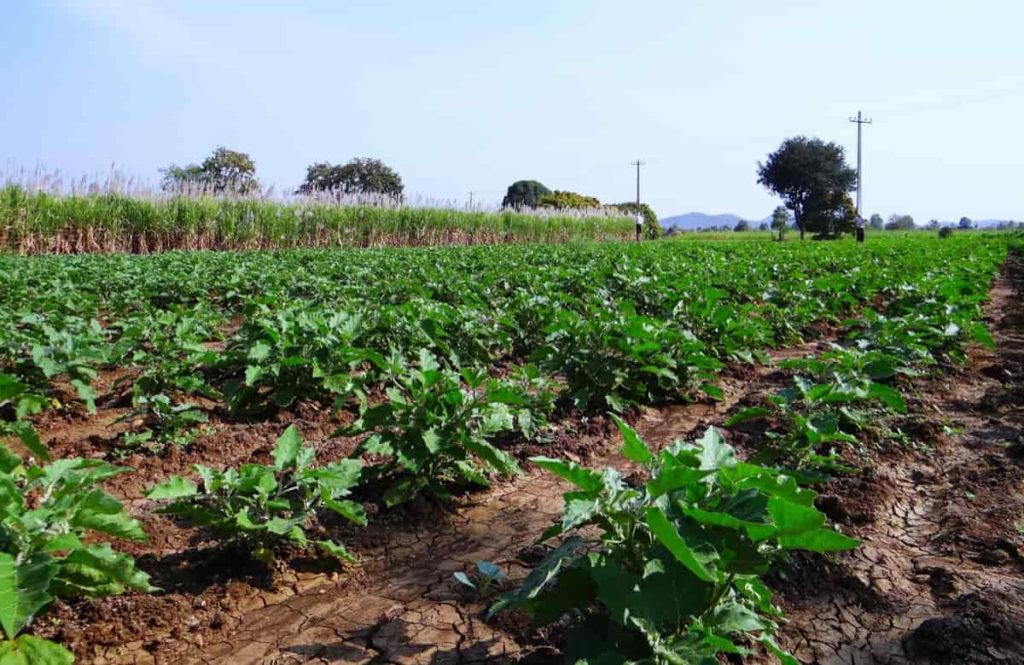
Vegetable plant spacing chart in India
How do you plan plant spacing?
As a matter of thumb, you should provide as much room as the plant’s mature breadth requires. For instance, a plant predicted to spread 40 feet wide should be spaced apart from its neighboring trees by the same amount. A tree with a projected radius of 30 feet should be spaced 50 feet apart from one with a projected radius of 20 feet since the combined radii of the two trees would equal 60 feet.
Even if this is a good rule of thumb, there are numerous landscaping scenarios when deviating from it makes more sense. Plants can be spaced closer together for certain purposes, but sometimes it’s more effective to spread them apart to achieve a certain look.
How close can vegetables be planted?
Space recommendations can be changed if crops can be grown closer together or if soil quality improves. Carrots, green onions, and radishes need at least three inches of spacing. Vegetables such as beets, leeks, garlic, spinach, onions, and turnips need a spacing of 4 to 6 inches on both sides, whereas vegetables such as celery, leaf lettuce, and Swiss chard need 7 to 9 inches. Space your head lettuces out by ten to twelve inches on both sides.
In case you missed it: Top 19 Steps/Ways/Methods to Boost Lettuce Yield: How to Increase Production, and Quality
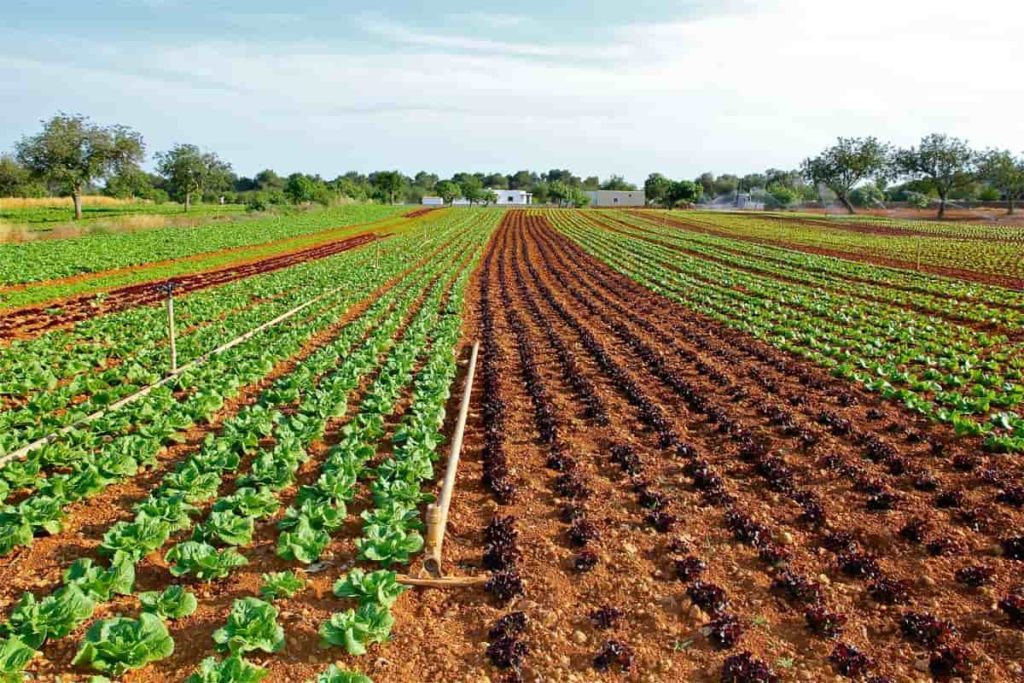
Planting corn in blocks helps ensure even pollination, so try doing so by spacing your seeds 12 inches apart on a raised bed. Tomato plants need a perimeter of 12 inches, whereas pepper plants, potatoes, and cabbages need 15 to 18 inches. In a typical garden, the rows must be wide enough for people to easily walk between them without trampling the plants’ delicate roots. Plants like squash, cucumbers, and pumpkins, which grow on vines, need much space between rows so they may cover a large area.
Low-growing vegetables and beans like bush beans need space between rows to prevent competition for water and nutrients. Plants can only be placed so near one another in a row, however, because of the need to create broad rows between them. The practice of broadcast seeding, in which seeds are not sown in perfect rows but rather distributed throughout the surface of the soil, is well suited to a raised garden bed because of its open, spacious nature. For example, this technique benefits from spinach, chard, lettuce, and herbs.
Vegetables bred for early harvest have their seeds dispersed in the same way. When cultivated for their leaves, radishes, spring onions, and beets are among them. Seeds are broadcasted at about half an inch or about right for germination and growth. When growing spinach for use as little sensitive spring greens, such as in a mesclun mix, thinning the plants when they reach useable size allows more room for the others to continue growing.
When transplanting established seedlings onto the raised garden, space them to be half as near as you would in a regular garden. If the plants seem too close together, or if you need to dig near the roots of a nearby plant, use your best judgment. Although it is desirable to maximize available area, it is important not to crowd the plants, as this might cause them to suffer from insufficient water and food.
In case you missed it: Best Season to Grow Onions at Home in India: in Pots, Terrace, Apartment Balcony, and Backyards
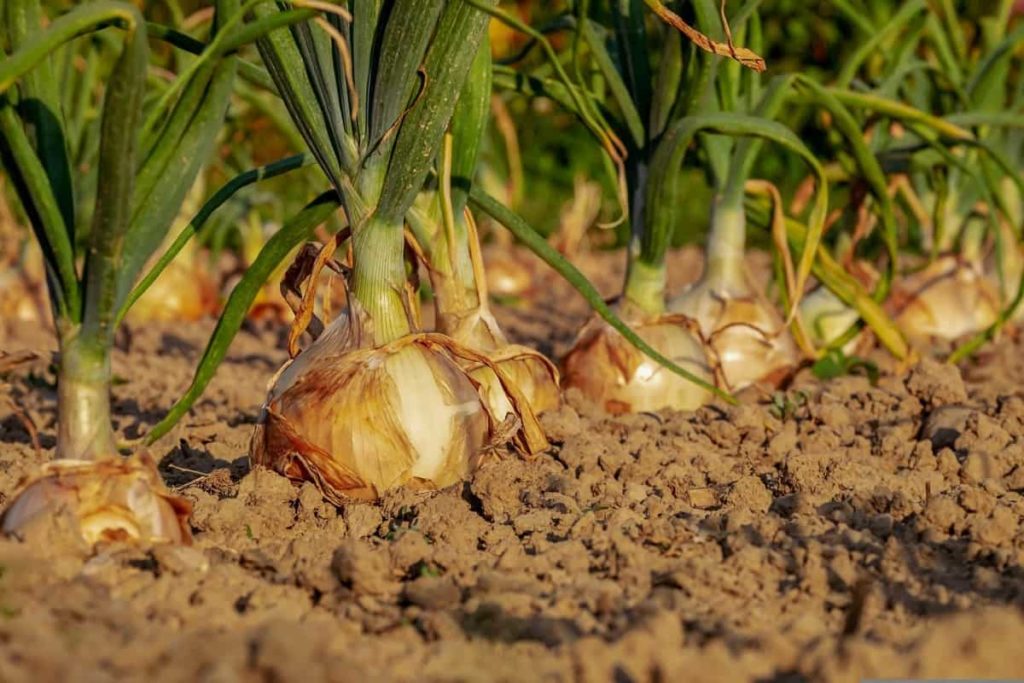
As water can more easily escape through the bottom and sides of a raised vegetable garden bed, the soil in such a bed dries up more rapidly. Beds, which often have denser plant arrangements than traditional gardens, need more consistent watering to promote healthy plant growth. Vining plants benefit greatly from being grown vertically since this allows for much closer spacing between plants. Peas, squash, pole beans, cucumbers, and tiny pumpkin cultivars can be planted half as far apart vertically.
What is a good-sized garden?
It depends on many factors. The average individual needs around 200 square feet of garden area to produce enough food to last a year. A garden plot about 20 by 40 feet would be ideal for a household of four. Consider, too, that certain crops need more room than others. Brussels sprouts, asparagus, and huge melons and squash will need more space. The quantity to plant is totally up to you and your loved ones’ preferred selection of vegetables.
There is a wide range in potential yield from a single plant. In any case, here are a few things to think about when you lay out your garden. It’s possible that you wouldn’t be able to produce much of anything for a good chunk of the year if you lived in a very chilly section of the nation. You need to think about it. Putting part of your summer harvest away for the winter is one strategy for dealing with the difficulties that come with the cold. You’ll need a few more plants if you want to store any of your produce.
How much space do tomatoes need?
Tomato plants should be spaced anywhere from 18 to 24 inches apart. However, the exact distance can vary greatly depending on the variety you choose to grow. Seek out information on the specific type, and then adhere to the recommendations for planting distances on the seed packaging or plant tag. Plants of determinate tomato cultivars should be spaced 18-24 inches apart since they only reach a specific height before stopping to fruit.
In case you missed it: How to Start Bell Pepper Farming in the USA: Production, and A Step-by-Step Growing Guide for Beginners
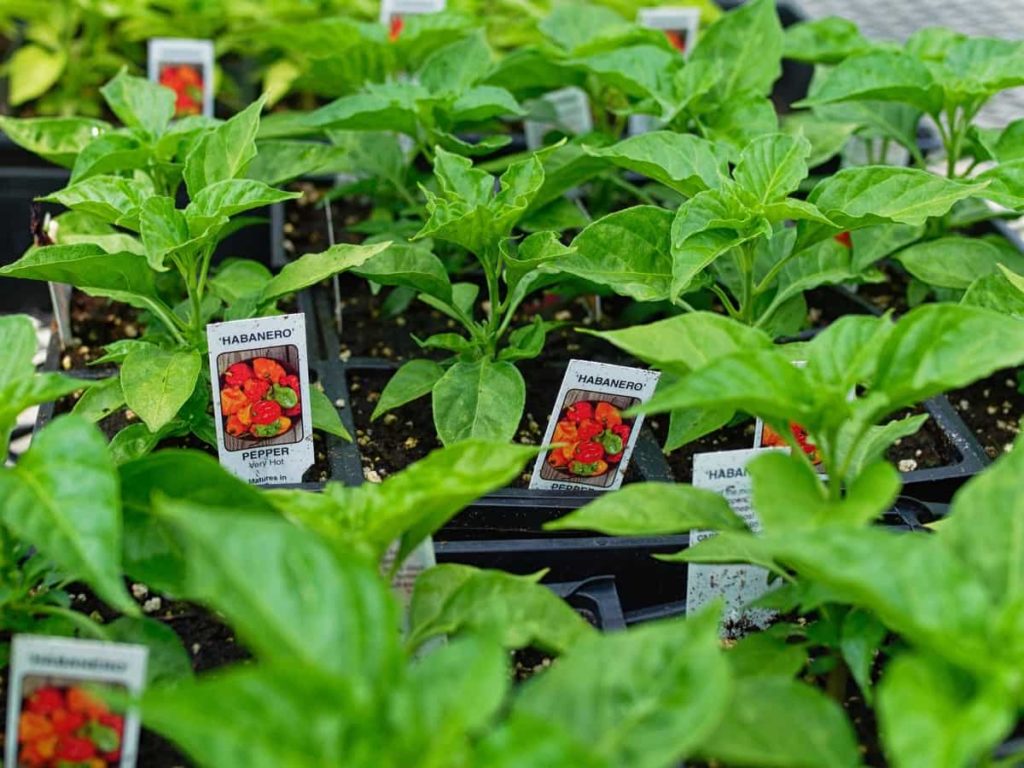
Planting space requirements vary depending on the determinate tomato variety, with compact or dwarf types requiring as little as 12 inches between plants. Indeterminate tomato plants, often known as vining plants, keep growing and spreading until they are either clipped or destroyed by cold. While they can be planted as close as 18 inches apart, they can benefit from the extra room since they tend to grow upwards rather than outwards, like determinates.
Except for tiny container tomato plants, which may be grown in 12-inch wide and deep pots, tomato plants should be cultivated one per container in 18 or 24-inch wide and deep containers. It would be tempting to cram as many tomato plants as possible into a small pot, but each plant needs its area to thrive. To complement your tomato, plant some lettuce or marigolds, which are both low-growing and won’t steal any attention away from your crop.
If you’re planting in rows, you could have more room if you’re planting in the ground. Planting tomatoes 18–24 inches apart in a row, with 36–48 inches between rows, works well. If you do this, you’ll have enough space between the rows. Keep the plants at a consistent 18-24 inches apart if you’re planting densely in the ground instead of in rows, but plan for how you’ll get to them without trampling them.
The 18-24 recommendation for heavy planting in the ground also applies to growing in raised beds. Your elevated bed’s depth should also be considered. You can get away with somewhat tighter spacing in 12 inches or deeper soil since there will be more nutrients and room for the plant’s roots.
What happens if you plant vegetables too close together?
Overcrowding plants not only stunts their development but also invites pests and diseases. When seedlings are too close together, they block the sun’s light for one. Sadly, the situation will only worsen as they continue to grow in size.
In case you missed it: How to Start Potato Farming in USA: A Step-By-Step Production/Growing Guide for Beginners
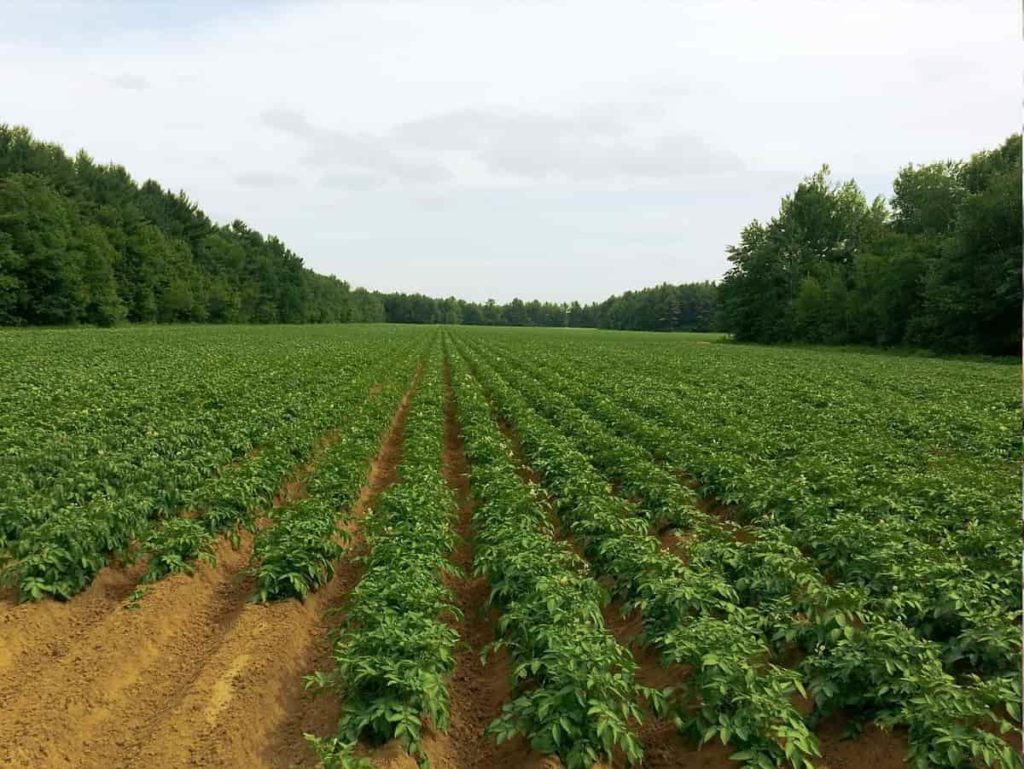
Can you plant vegetables closer together in raised beds?
Raised beds and interplanted gardens have closer plant spacing than conventional row gardens. Plants in one row should be spaced apart such that there is one space between each pair of plants in the next row for producing vegetables, herbs, or fruits. Having a nearly constant layer of leaves produces a protective barrier against the sun that helps keep weeds at bay and decreases the area that has to be covered with mulch.
Add up the inches between rows of each crop, then divide that number by 2 to obtain the interplanting spacing. Plant radishes 3 inches away from the beans. Plant diseases are more likely to spread if seeds are planted too closely. The instructions on the seed packaging should always be followed.
What is row spacing?
Controlling the distance between rows is a simple strategy that has significantly affected weed density in some crops. The arrangement of crops in a field is determined by the row spacing and the seeding rate, which in turn affects the pace at which the crop canopy closes and the growth of weeds between the rows.
Weeds can cause considerable output loss by outcompeting crops for sunshine, nutrients, water, and space. Faster shading, less dependence on pesticides later in the season, and fewer weeds are all benefits of narrow row spacing, which shortens the time it takes for the crop to shut its canopy.
Can two tomato plants be planted together?
Planting tomatoes too closely together might cause diseases. It is possible to plant tomatoes nearby, but you may have trouble getting them to thrive. Improper spacing can prevent tomatoes from growing deep roots. Roots being entangled reduces nutrition uptake for both tomatoes. As a result, diseases like blight fungus are more likely to spread between the two tomato plants. To prevent these problems, the plant simply has one tomato per container.
Since tomatoes can be self-pollinated, you can grow them in a single pot. This indicates that the plant can produce both male and female blooms. This means a single tomato plant may be grown and nurtured into fruitfulness. Given that tomato plants can pollinate themselves, spacing between them is not very important. Overcrowded tomato plants will fight over limited nutrients. If you plant tomatoes too closely together, they won’t grow well. Tomato plants are competitive and have high resource requirements.
This implies they will likely rob their immediate neighbors of any resources they can access. Some of the plants will thrive, while others will struggle as a result of this. However, if things go badly, your crops will all be stunted. Depending on the tomato you’re producing, you’ll need to allocate different amounts of area in your garden. Indeterminate and determinate tomatoes are the two most common kinds.
Tomato plants of the indeterminate, or vining, tend to climb rather than spread their leaves. They can be spaced more closely thanks to their ability to expand upward. When planted in the ground, they must be separated by 18 inches (45 cm). Tomatoes with vines that can’t be cut back should be planted 18 inches (45 cm) apart. Plant bush-type, or determinate, tomatoes 18-24 inches (45-60 cm) apart.
More soil and space between plants are required for determinate tomato types. Because of their horizontal and vertical expansion, they are more likely to struggle for resources like water and light. Plants need to be spaced at least 18-24 inches (45-60 cm) apart. If you want to be on the safe side, give your tomato seedlings a little more room than you think they’ll require.
In case you missed it: Tomato Farming Business Plan: A Production and Cultivation Guide for Beginners
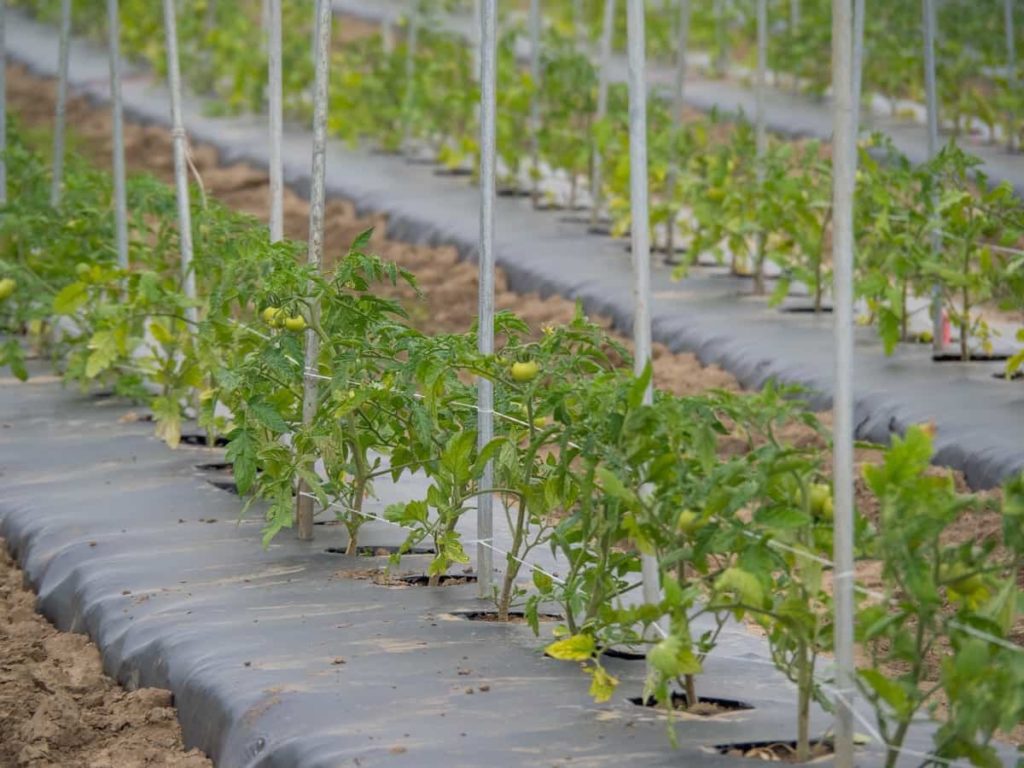
How much space do tomatoes need in containers?
Container-grown tomatoes have the same spacing requirements as field-grown tomatoes. When growing tomatoes in pots, leave at least 18-24 inches (45-60 cm) between each plant. Tomatoes, on the other hand, should be grown in individual pots. In this respect, it’s comparable to growing acorn squash and other garden plants.
Tomatoes do best when planted individually. Tomatoes need to be spaced 18-24 inches (45-60 cm) apart in a container. Avoid planting many tomatoes in the same hole. Plant tomatoes separately unless using a large container. This way, the root systems won’t have to work against one another to get the necessary moisture and nutrients. In general, you should provide your tomatoes with as much space as they need to thrive.
What is the best spacing for carrots?
Sow carrot seeds a quarter of an inch deep and an inch apart. Plant carrots in rows 16-24 inches apart and thin them down to 2-3 inches in the late spring. You can plant carrot seeds outside when the soil temperature is at least 45 degrees Fahrenheit. The carrot rust fly, cutworm, carrot weevil, flea beetle, slugs, slugs, leaf blight, and soft rot are some of the pests and diseases that can affect carrot plants. On a cloudy day, you could choose plant-resistant types and thin plans. Carrots are harvested by pulling them up by their tips.
Vegetable plant spacing chart in India (seed spacing, plant-to-plant distance, row-to-row distance)
| Vegetable | Method of sowing | Depth for sowing(inches) | Sowing distance (inches/feet) | Days to maturity |
| Melon | Direct | 1 | Between seeds: 18” to 24” Between rows: 35” | 70 to 85 days |
| Corn | Direct | 1 to 1.5 | Between rows: 30” to 36” Between seeds: 4“ to 6“ | 60 to 100 days |
| Pumpkin | Direct | 1 | Between rows: 35” Between seeds: 24“ to 48“ | 70 to 75 days |
| Potato | Direct | 4 | Between rows: 12“ to 18“ | 70 to 120 days |
| Cauliflower (early) | Transplant | 0.5 | Between rows: 2 ft Between transplants: 2 ft | 120 to 125 days |
| Cauliflower (late) | Transplant | 0.5 | Between rows: 2 ft Between transplants: 2 ft | 120 to 125 days |
| Cauliflower (midseason) | Transplant | 0.5 | Between rows: 2 ft Between transplants: 2 ft | 120 to 125 days |
| Turnip | Direct | 0.5 | Between rows: 1.5 ft Between seeds: 4” | 40 to 50 days |
| Tomato | Transplant | 0.25 | Between rows: 2.5 ftBetween transplants: 1 ft | 110 to 115 days |
| Spinach | Direct | 0.5 | Between rows: 9 ft Between seeds: 3 ft | 60 days |
| Radish | Direct | 0.5 | Between rows: 12” Between seeds: 2“ to 3“ | 40 to 45 days |
| Peas | Direct | 1 | Between rows: 12“ Between seeds: 4“ | 55 to 60 days |
| Onion | Transplant | 0.25 | Between rows: 2.5 ft between transplants: 1 ft | 150 to 160 days |
| Okra | Direct | 0.5 | Between rows: 18“ Between seeds: 12“ | 45 to 50 days |
| Lettuce | Direct/ Transplant | Surface sow cover lightly with soil | Between rows: 8“ to 12“ | 45 to 55 days |
| Beans | Direct | 1 to 1.5 | Between rows: 18“ Between seeds: 8“ | 45 to 50 days |
| Cucumber | Direct | 0.5 | Between rows: 12“ Between seeds: 6” | 50 to 70 days |
| Carrot | Direct | 0.25 | Between rows: 6 ft between transplants: 4 ft | 75 to 80 days |
| Capsicum | Transplant | 0.25 to 0.5 | Between rows: 1.5 ft Between transplants: 1.5 ft | 95 to 100 days |
| Cabbage | Transplant | 0.25 | Between rows: 1.5 ft between seeds: 2“ | 90 to 100 days |
| Broccoli | Transplant | 1.5 | Between rows: 1.5 ftBetween transplants: 1 ft | 90 to 100 days |
| Bottle gourd | Direct | 1-2 | Between rows: 4 ft Between seeds: 1 ft | 55 to 60 days |
| Bitter gourd | Direct | 0.5 | Between rows: 4 ft Between seeds: 1 ft | 55 to 60 days |
| Beetroot | Direct | 1 | Between rows: 18“ Between seeds: 4” | 80 to 90 days |
| Apple gourd | Direct | 1 | Between rows: 12“ Between seeds: 12“ | 70 to 80 days |
Conclusion
Feeding your plants with quality organic food will ensure they receive all the nutrients they need for optimal development, regardless of the above vegetables you decide to cultivate. We made this chart/calendar to help you cultivate your favorite vegetable at home. Plant some seeds, and you’ll be well on discovering the wonders of organic gardening and better health.
- Economical Aquaculture: A Guide to Low-Budget Fish Farming
- 15 Common Planting Errors That Can Doom Your Fruit Trees
- How to Make Houseplants Bushy: Effective Tips and Ideas
- Innovative Strategies for Boosting Coconut Pollination and Yield
- Pollination Strategies for Maximum Pumpkin Yield
- The Complete Guide to Chicken Fattening: Strategies for Maximum Growth
- Natural Solutions for Tulip Problems: 100% Effective Remedies for Leaf and Bulb-Related Issues
- Revolutionizing Citrus Preservation: Towards a Healthier, Greener Future
- Natural Solutions for Peony Leaf and Flower Problems: 100% Effective Remedies
- Maximizing Profits with Avocado Contract Farming in India: A Comprehensive Guide
- Natural Solutions for Hydrangea Problems: 100% Effective Remedies for Leaf and Flowers
- The Ultimate Guide to Choosing the Perfect Foliage Friend: Bringing Life Indoors
- From Sunlight to Sustainability: 15 Ways to Use Solar Technology in Agriculture
- The Ultimate Guide to Dong Tao Chicken: Exploring from History to Raising
- The Eco-Friendly Makeover: How to Convert Your Unused Swimming Pool into a Fish Pond
- Mastering the Art of Delaware Chicken Farming: Essentials for Healthy Backyard Flocks
- 20 Best Homemade Fertilizers for Money Plant: DIY Recipes and Application Methods
- How to Craft a Comprehensive Free-Range Chicken Farming Business Plan
- Brighten Your Flock: Raising Easter Egger Chickens for Beauty and Bounty
- How to Optimize Your Poultry Egg Farm Business Plan with These Strategies
- Subsidy for Spirulina Cultivation: How Indian Government Schemes Encouraging Spirulina Farmers
- Ultimate Guide to Raising Dominique Chickens: Breeding, Feeding, Egg-Production, and Care
- Mastering the Art of Raising Jersey Giant Chickens: Care, Feeding, and More
- Ultimate Guide to Raising Legbar Chickens: Breeding, Farming Practices, Diet, Egg-Production
- How to Raise Welsummer Chickens: A Comprehensive Guide for Beginners
- How to Protect Indoor Plants in Winter: A Comprehensive Guide
- Ultimate Guide to Grow Bag Gardening: Tips, Tricks, and Planting Ideas for Urban Gardeners
- Guide to Lotus Cultivation: How to Propagate, Plant, Grow, Care, Cost, and Profit
- Agriculture Drone Subsidy Scheme: Government Kisan Subsidy, License, and How to Apply Online
- Ultimate Guide to Raising Araucana Chickens: Breed Profile, Farming Economics, Diet, and Care
- Bringing Hydroponics to Classroom: Importance, Benefits of Learning for School Students
- Ultimate Guide to Raising Polish Chickens: Breed Profile, Farming Economics, Diet, and Care
- Ultimate Guide to Raising Australorp Chickens: Profile, Farming Economics, Egg Production, Diet, and Care
- Silkie Chicken Farming: Raising Practices, Varieties, Egg Production, Diet, and Care
- Sussex Chicken Farming: Raising Practices, Varieties, Egg Production, Diet and Care
- Homemade Feed Formulations for Livestock: Discover Cost-effective Starter to Finisher Feed Recipes
Thank you very helpful totally was not aware of the planting ,blindly we use to plant, ,please mail me all the details available about farming , i want details about mango farming i am supposed to start,please send the details and the availability of the plants, price, and total solutions.